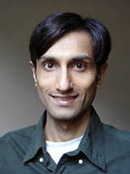
Ever Try Herding Cats?

Dr. Pushker A. Kharecha
Meet Pushker A. Kharecha, Ph.D., a climate scientist who works for the NASA Goddard Institute for Space Studies and Columbia University Earth Institute in New York.
Kharecha and his colleagues (Charles F. Kutscher, James E. Hansen, and Edward Mazria) recently offered potential solutions to anthropogenic climate change, and he was willing to answer a few questions regarding his thinking on the science of the topic.
Kharecha said: "Global climate change over the past 50 years or so is dominated by human activities, specifically the emission of greenhouse gases (GHGs) into the atmosphere (mostly by fossil fuel burning, secondarily by deforestation and other land use change). This basic conclusion is shared by every major national science academy (including ours) as well as numerous professional Earth science societies and other scientific bodies around the world (that is, it's absolutely not just the IPCC).
"Such broad scientific consensus occurred after many decades of serious work by many thousands of scientists around the world. There's a well-known notion that getting this many scientists to agree on something this big is like trying to herd cats! The notion of "global cooling" that was much hyped in the 1970s was never even remotely close to being a consensus view."
Broadly, his reasoning is this:
"Multiple lines of observational evidence show that the rise in GHGs over the past ~200 years is due to the above human activities, and fairly elementary physics that has been well-established for over a century tells us that the more GHGs that are added to the atmosphere, the warmer the climate system will get.
"The possible global climate change drivers are natural variability within the climate system (El Niño-Southern Oscillation, Pacific Decadal Oscillation, etc.); natural external factors (that is, solar energy output, volcanoes, etc.); and human factors (emissions of GHGs and aerosols). Lines of observational evidence and basic physics lead us to conclude that natural internal variability isn't the culprit. Likewise, the changes in solar output measured by satellites are not sufficient to explain the global temperature trend ─ plus, if the warming was caused only or largely by the sun, we would see heating distributed vertically throughout the atmosphere, but we don't (measurements show that the air warming is limited to the lowest layer of the atmosphere ─ a very strong indicator of the greenhouse effect). Also, large volcanic eruptions like Mt. Pinatubo in 1991 tend to cool the planet, not warm it. So taken by themselves, these natural external factors should have led to a cooling trend. However, the trends in the rate, spatial distribution, and magnitude of human-induced GHG concentration changes do explain the observed warming trend very well.

Photo courtesy of the South Carolina Department of Natural Resources.
"Measurements show that the global ocean has warmed significantly (down to several thousand meters at least), as has solid Earth. Global precipitation patterns have changed significantly over the past several decades. Perhaps the most revealing warming trend is the observed worldwide net loss of ice over the 20th century ─ most notably from mountain glaciers and Arctic summer sea ice, but the Antarctic and Greenland ice sheets also show clear signs of net loss of ice."
He noted that more detail is available at www.ipcc.ch/publications_and_data/ar4/wg1/en/ch9s9-7.html.
Concerning climate models, Kharecha explained: "I'm not aware of any climate scientist who thinks the models are perfect, or that they should be the sole basis for making relevant policy decisions. Such decisions should be based on ALL lines of relevant science, not just models. And based on my understanding, this is precisely what the EPA's decision on GHGs was based on."
Kharecha's article, "Options for Near-Term Phaseout of CO2 Emissions from Coal Use in the United States" outlines real strategies that can be used today. Those strategies include:
- eliminating subsidies for fossil fuels;
- putting rising prices on carbon emissions;
- improving electricity transmission and energy efficiency in homes, commercial buildings, and appliances;
- replacing coal power with biomass, geothermal, wind, solar, and third-generation nuclear power; and after successful demonstration at commercial scales, deployment of fourth-generation nuclear power plants; and
- carbon capture and storage at remaining coal plants.
It seems to me that we are already working on some of the strategies. Do you think his science is as sound as possible?
Posted by L.K. Williams, EPonline on May 17, 2010